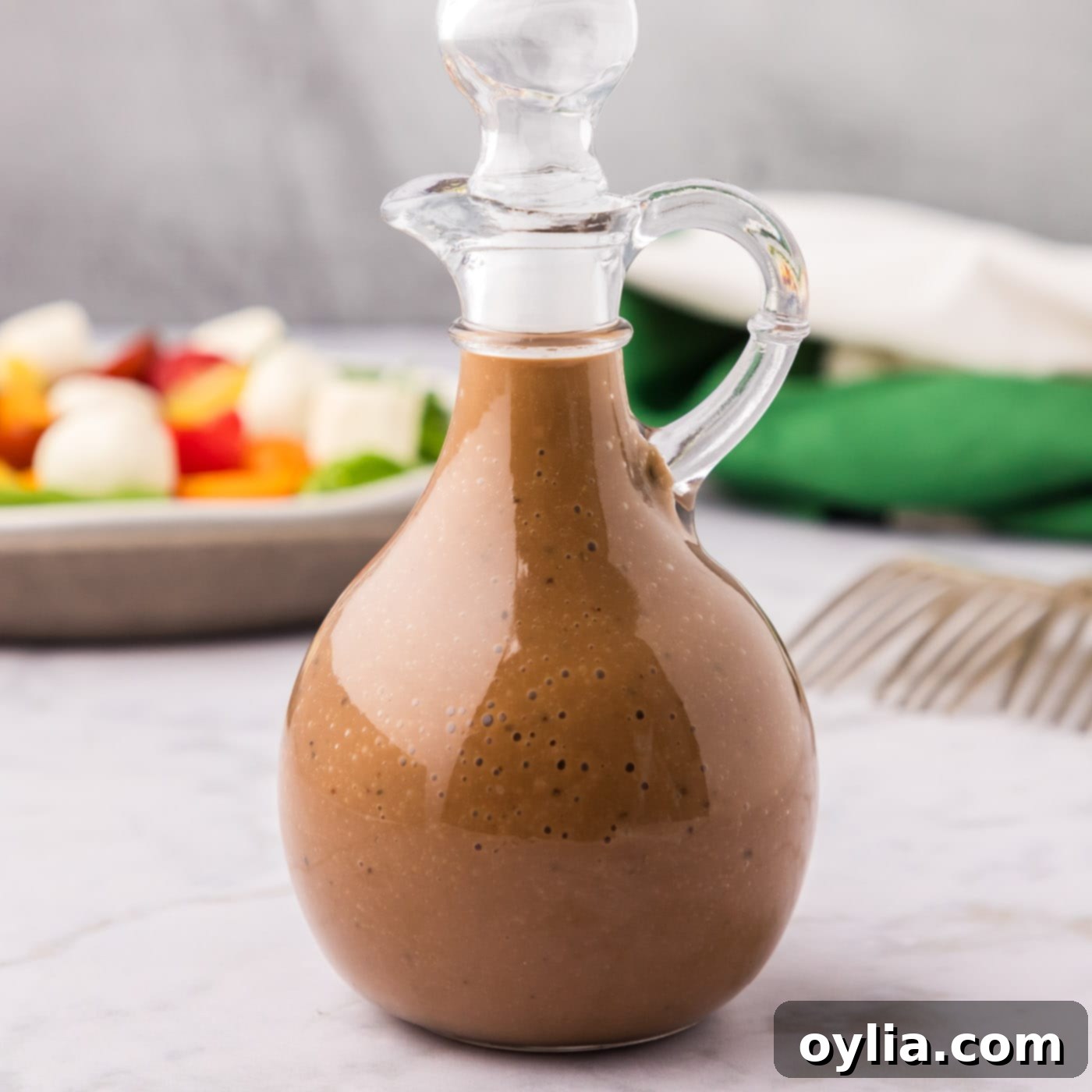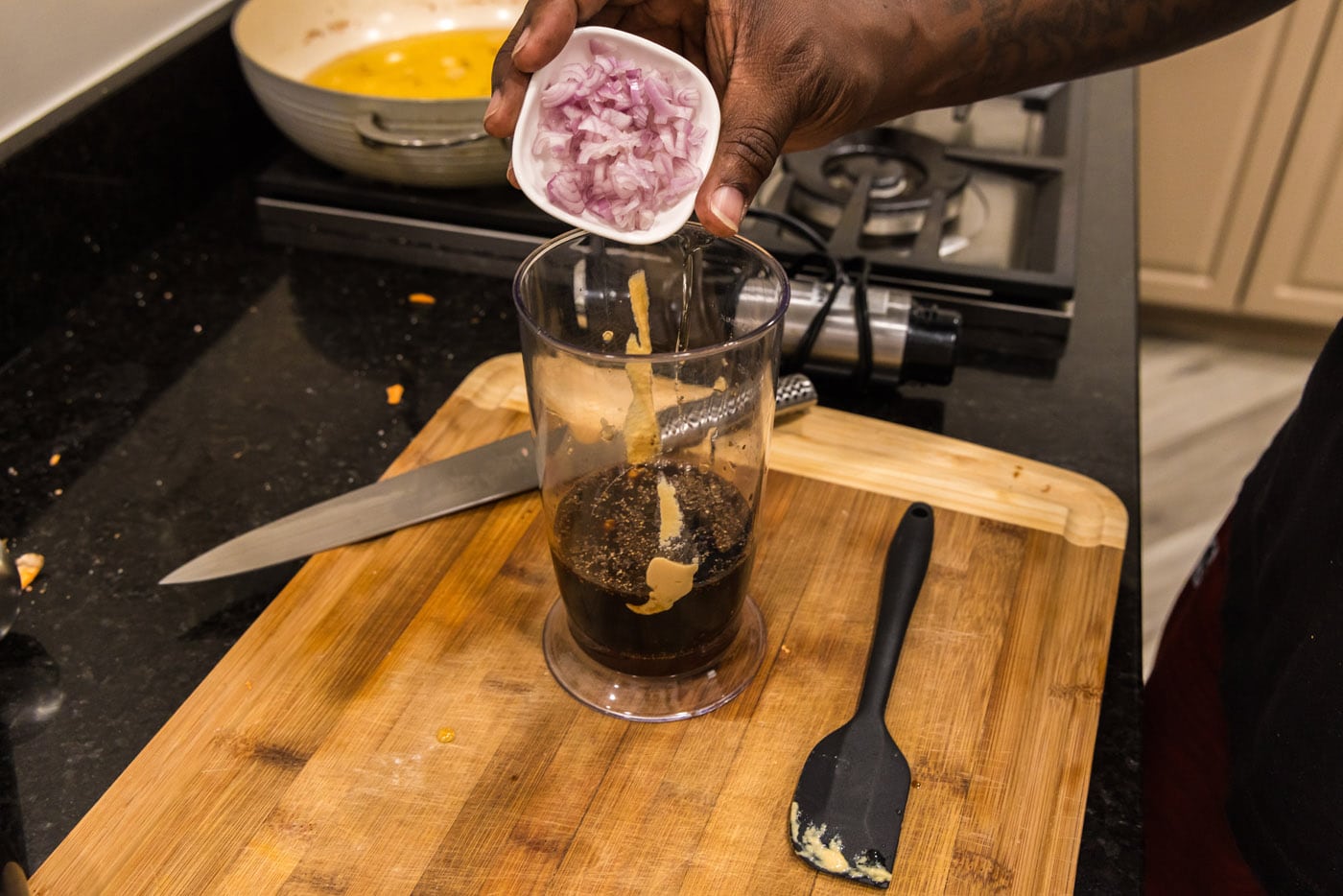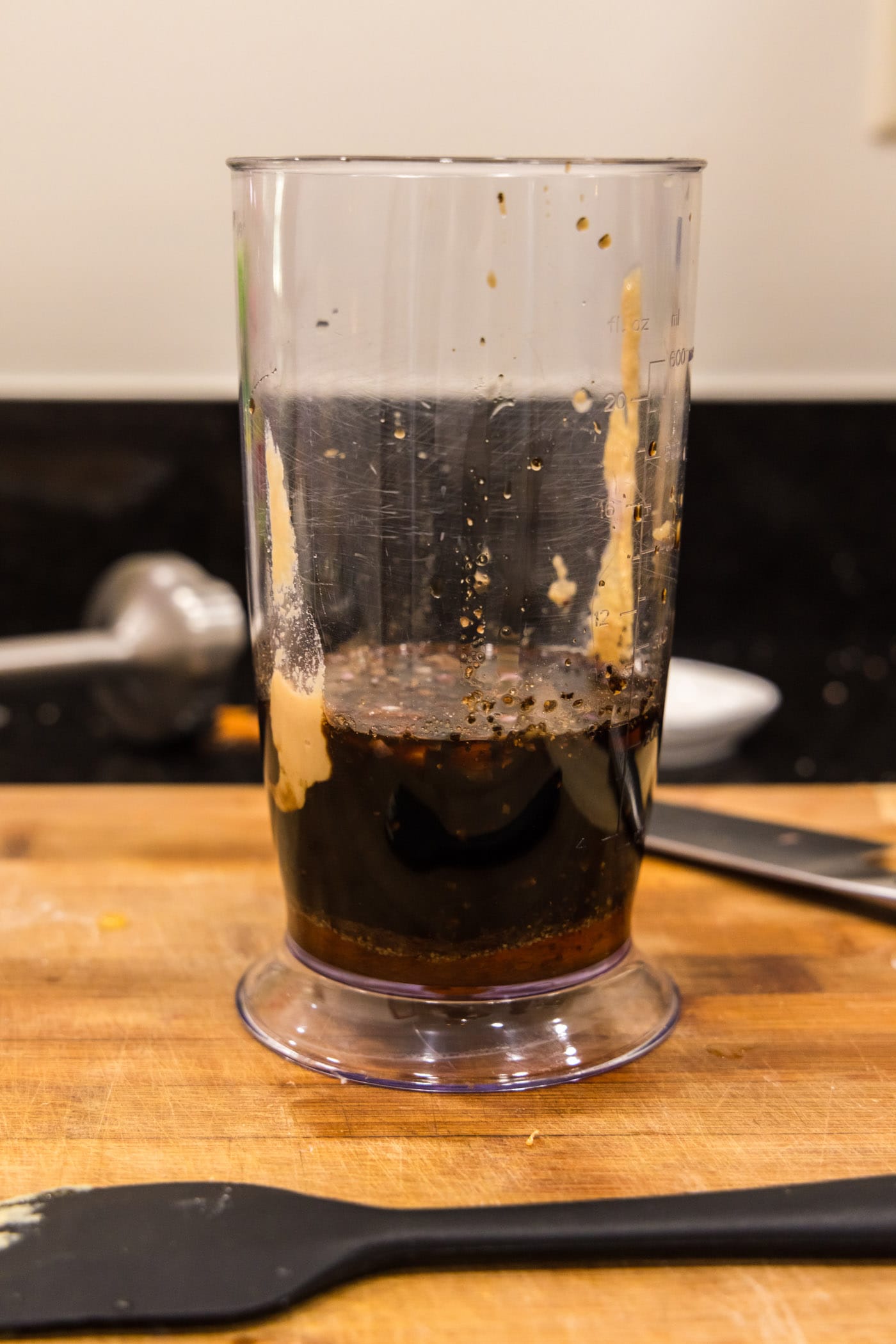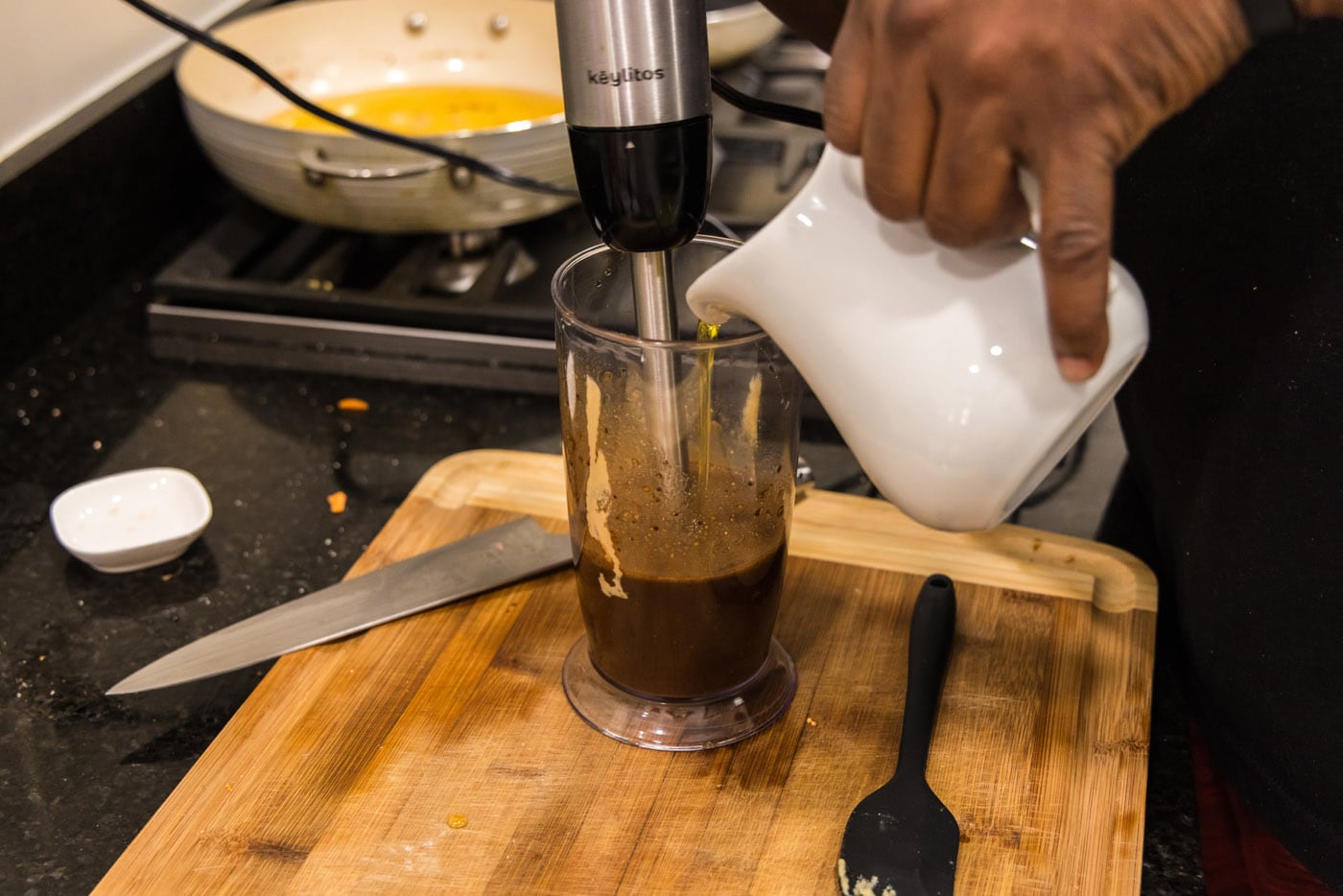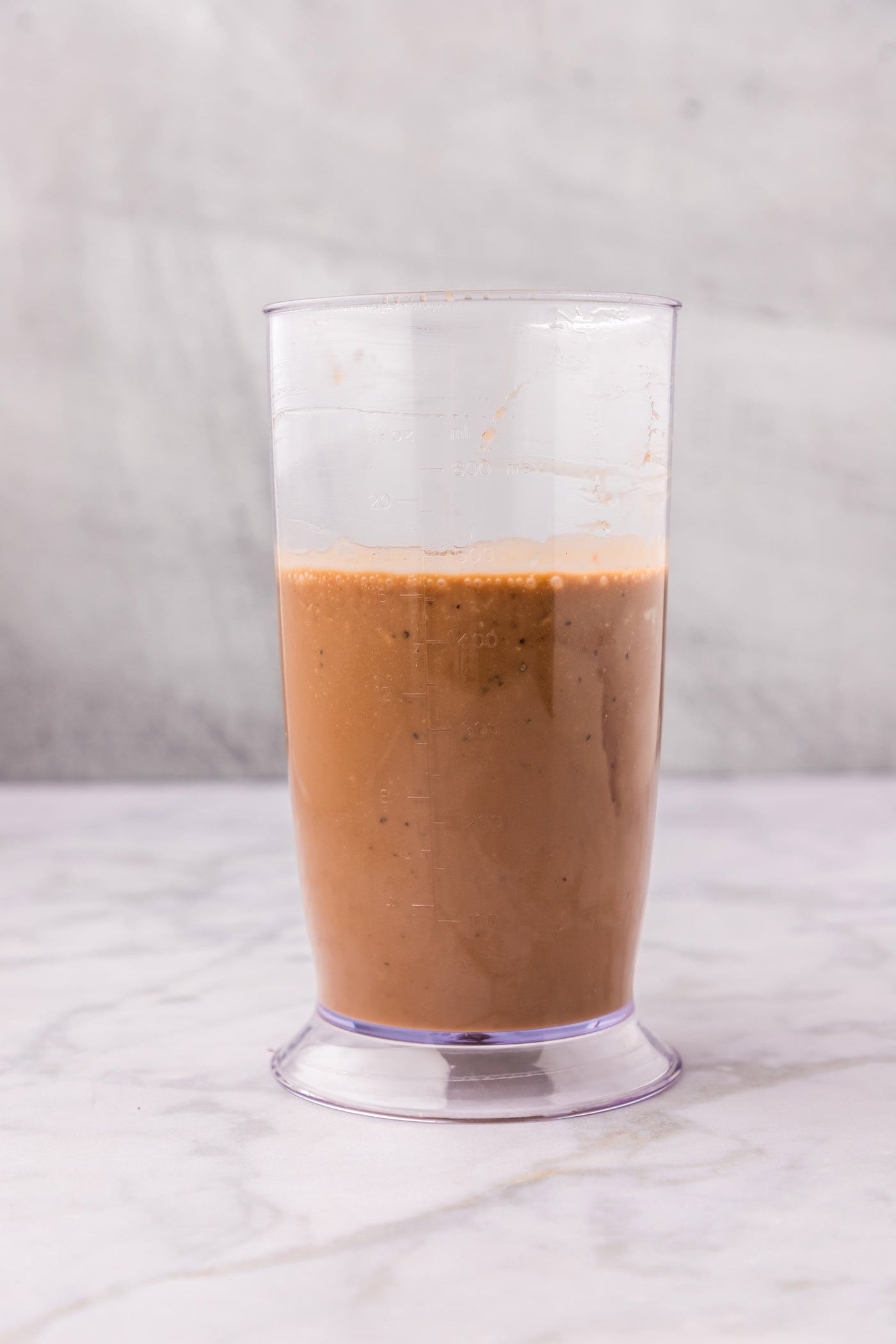Easy Homemade Balsamic Vinaigrette: Your Go-To Recipe for Flavorful Salads and More
Tired of bland store-bought dressings that lack punch and often contain questionable ingredients? Get ready to transform your meals with our ultimate recipe for homemade balsamic vinaigrette! This tangy, zesty, and subtly sweet dressing is incredibly easy to make from scratch, coming together in a matter of minutes. Beyond just elevating your everyday salads, its rich and robust flavor profile makes it a versatile companion for everything from vibrant grilled vegetables and hearty grain bowls to succulent marinated proteins.
Creating your own vinaigrette at home not only gives you complete control over the quality of ingredients and the flavor balance, but it’s also more cost-effective and free from artificial preservatives. You’ll be amazed at the difference a fresh, homemade dressing can make to your culinary creations. Forget the bottled stuff; once you taste the bright, harmonious flavors of this simple balsamic vinaigrette, you’ll never go back.
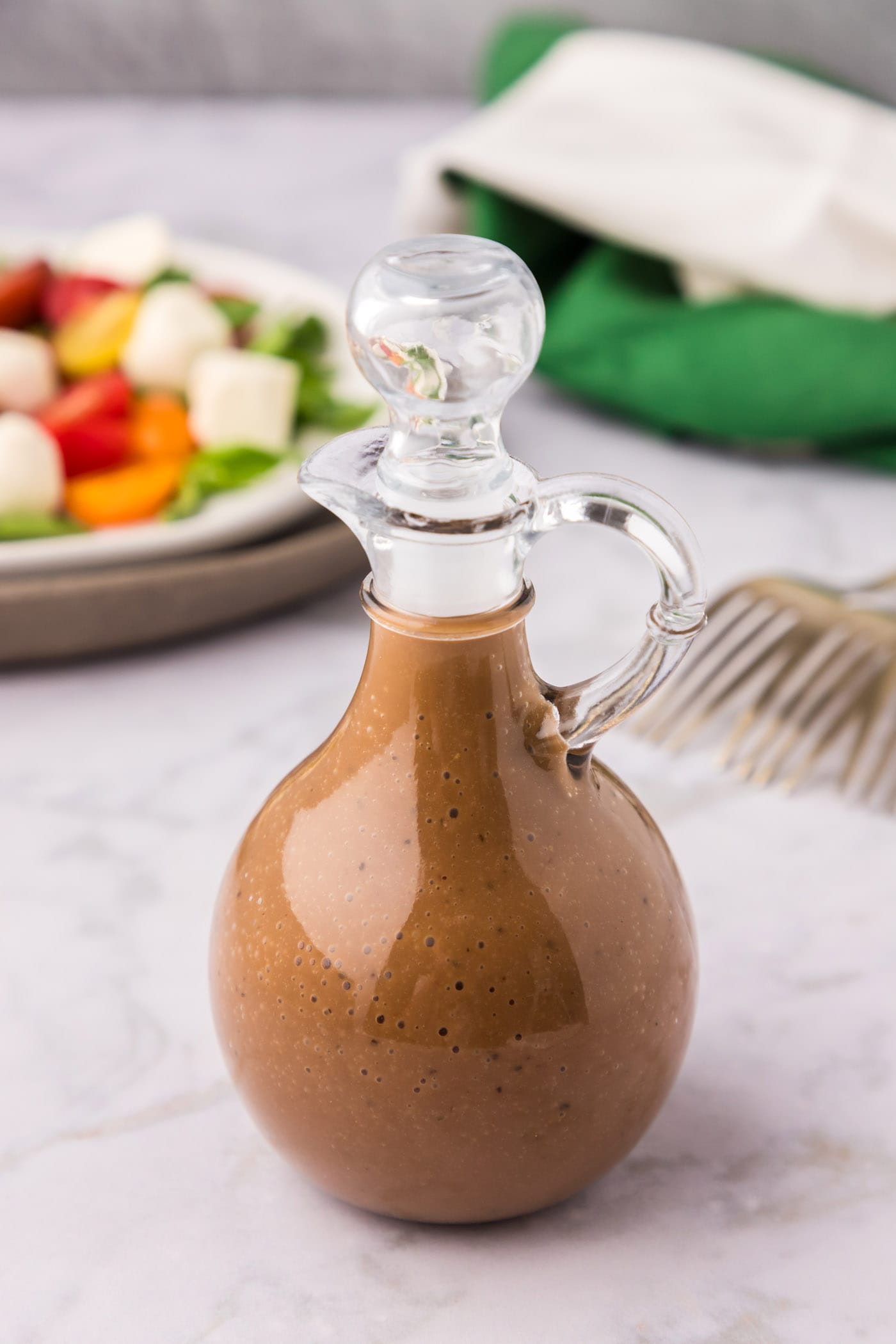
Why This Homemade Balsamic Vinaigrette Recipe Works
This balsamic vinaigrette isn’t just another dressing; it’s a culinary game-changer, and here’s why it deserves a permanent spot in your recipe collection. Firstly, its **unmatched versatility** sets it apart. While it’s a classic choice for fresh green salads – from simple mixed greens to elaborate Cobb or Caprese salads – its applications extend far beyond. Imagine it as a bright finish over roasted root vegetables, a zesty drizzle for grilled peaches, or a flavor-packed marinade that tenderizes and infuses chicken, fish, or tofu with a sophisticated taste.
The secret to its exceptional texture and ease lies in the preparation method. By using an **immersion blender**, we achieve a remarkably smooth, almost creamy consistency that’s often difficult to get with hand-whisking alone. This emulsification process ensures that the oil and vinegar are beautifully integrated, creating a stable dressing that coats your food perfectly without immediately separating. This method also makes it incredibly **quick to prepare**, cutting down your kitchen time significantly. You can literally have a gourmet-quality dressing ready in less than five minutes.
Furthermore, this recipe offers **superior flavor control**. Unlike store-bought options that can be overly sweet or too acidic, making it yourself allows you to adjust the balance of tanginess, sweetness, and savoriness to your personal preference. Whether you prefer it with a little more honey or a bolder garlic note, this recipe is incredibly adaptable. This ease of customization, combined with the fresh ingredients and simple technique, makes it a winning recipe for both novice and experienced cooks looking to add a touch of homemade excellence to their meals.
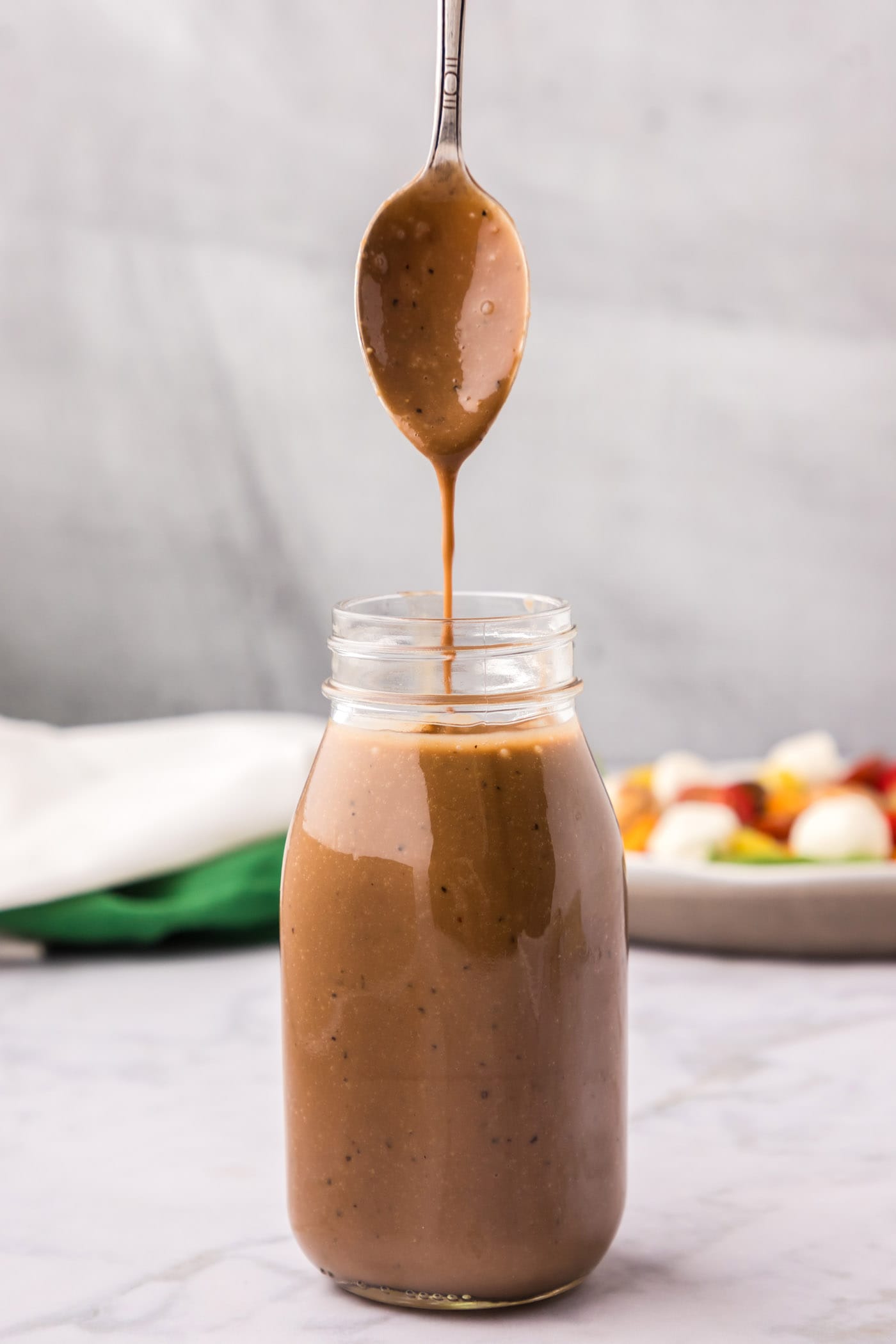
Key Ingredients You Will Need for the Best Balsamic Vinaigrette
Crafting the perfect balsamic vinaigrette starts with selecting quality ingredients. While the full list of measurements and detailed instructions can be found in the printable recipe card at the bottom of this post, let’s take a closer look at the components that make this dressing truly shine. Choosing fresh, high-quality ingredients will elevate the flavor of your vinaigrette, resulting in a more vibrant and satisfying experience.
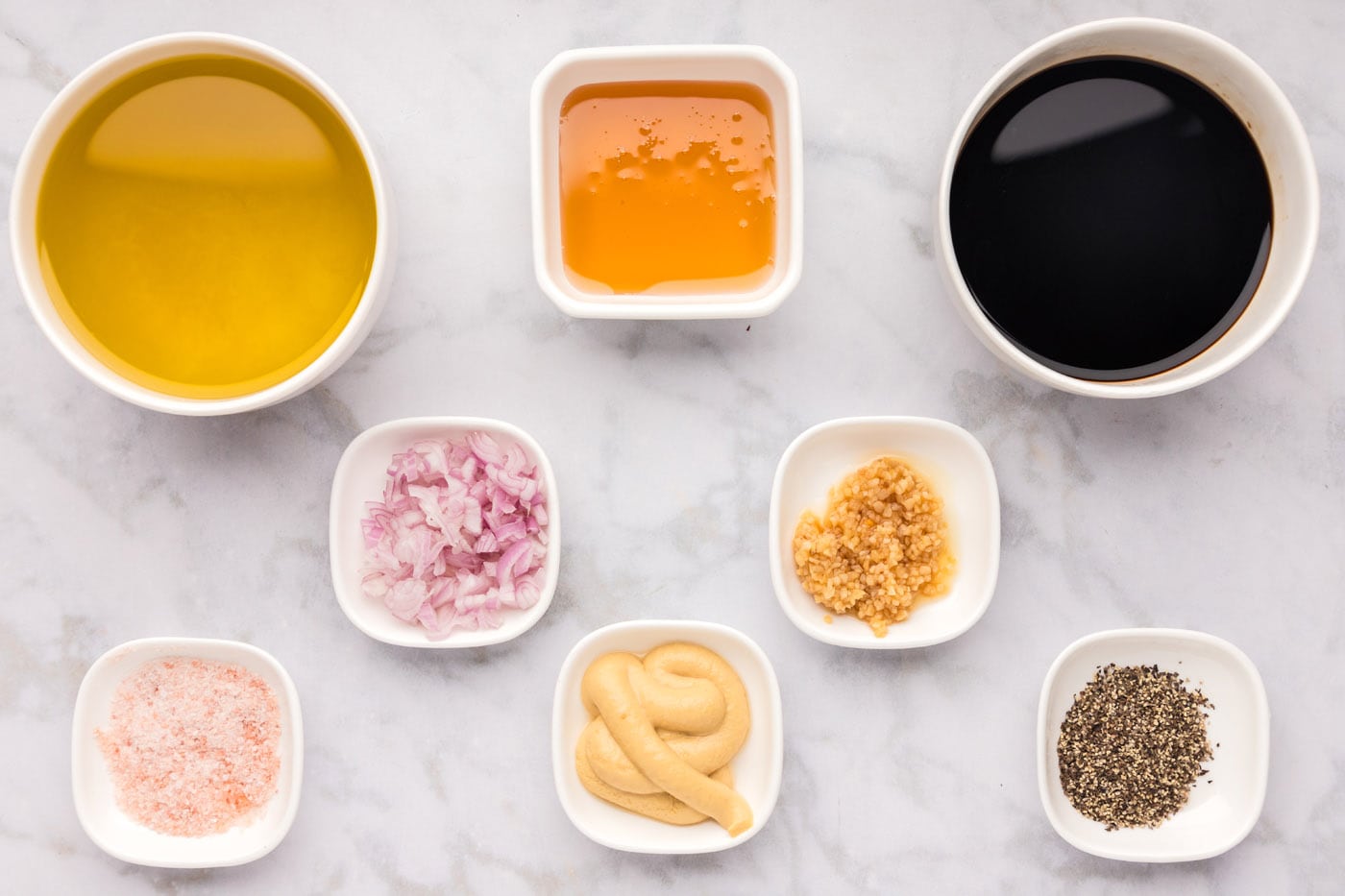
Ingredient Information and Smart Substitution Suggestions
Let’s dive deeper into each ingredient to understand its role and explore any potential swaps or considerations:
BALSAMIC VINEGAR – For this recipe, we recommend using a good quality, everyday balsamic vinegar. The quality of your balsamic vinegar significantly impacts the final taste of your vinaigrette. Look for brands that are naturally thick and have a rich, complex flavor. If you choose to use a more premium, aged balsamic vinegar – often characterized by its syrupy consistency and sweeter, more mellow flavor – you will likely need to significantly reduce the amount of honey in the recipe. Aged balsamic is naturally sweeter and thicker due to its longer fermentation process. Always taste as you go to achieve your desired balance.
HONEY – Honey acts as the primary sweetener, perfectly balancing the inherent tartness of the balsamic vinegar. It also contributes to the smooth texture of the dressing. You can adjust the quantity of honey to suit your personal preference for sweetness. For those seeking an alternative, maple syrup or agave nectar can be excellent vegan-friendly substitutes, offering similar sweetness with slightly different flavor undertones.
OIL – Our top recommendation is high-quality **extra-virgin olive oil**. Its fruity, peppery notes complement the balsamic beautifully and contribute healthy monounsaturated fats. However, if extra-virgin olive oil is not preferred or available, you have other options. Canola oil, sunflower oil, or a light olive oil can be used for a more neutral flavor profile. Be aware that using oils like sesame oil will introduce a distinct nutty flavor, significantly altering the traditional taste of the vinaigrette. For a lighter approach, you can even use a blend of extra-virgin olive oil with a more neutral oil.
HIMALAYAN SALT – We specify pink Himalayan salt for its mineral richness and beautiful color. If you don’t have it on hand, any coarse-grained salt like sea salt or kosher salt with a similar grain size will work perfectly. The key is to avoid substituting with an equal amount of fine-grain table salt. Table salt crystals are much smaller and denser, meaning a teaspoon of table salt will be significantly saltier than a teaspoon of Himalayan or kosher salt. Always start with less and add more to taste.
MINCED SHALLOTS – Shallots provide a delicate, sweet, and aromatic onion flavor that is milder than garlic or regular onions. They add a wonderful depth without overpowering the other ingredients. Freshly minced shallots are highly recommended for the best flavor and texture.
MINCED GARLIC – Fresh garlic is essential for that pungent, savory kick that rounds out the vinaigrette. Always opt for fresh garlic cloves and mince them finely for optimal flavor dispersion. Garlic powder can be used in a pinch, but fresh provides a superior taste.
DIJON MUSTARD – Dijon mustard is not just for flavor; it’s a crucial emulsifier in this recipe. Its natural compounds help to bind the oil and vinegar together, preventing separation and creating that desirable smooth, creamy texture. It also adds a subtle tangy, spicy note. Do not skip this ingredient!
BLACK PEPPER – Freshly ground black pepper is always preferred over pre-ground for its superior aroma and flavor. It adds a subtle warmth and a gentle bite to the vinaigrette.
How to Make the Perfect Balsamic Vinaigrette in Minutes
These step-by-step photos and instructions are designed to guide you through the process, making it incredibly simple to visualize how to create this delicious recipe. For a convenient printable version with all exact measurements and instructions, simply Jump to Recipe at the bottom of this post.
- Combine Initial Ingredients: Place all of your ingredients – balsamic vinegar, honey, minced shallots, minced garlic, Dijon mustard, black pepper, and pink Himalayan salt – into a tall, narrow container suitable for an immersion blender. It’s crucial to add the olive oil separately later, as this allows for proper emulsification.


- Emulsify with Olive Oil: Insert your immersion blender into the mixture. Begin blending on low speed, then gradually increase the speed. While blending, slowly and steadily drizzle in the extra virgin olive oil. This slow addition is key to achieving a stable emulsion, ensuring the dressing becomes smooth, thick, and uniformly creamy. Continue blending until all ingredients are thoroughly combined and the vinaigrette has reached your desired consistency.

- Chill and Serve: For the best flavor development and a slightly thicker texture, transfer the vinaigrette to a sealed container and chill it in the refrigerator for at least 30 minutes before serving. This resting period allows the flavors to meld beautifully.

- Storage: Store any leftover balsamic vinaigrette in an airtight container, such as a glass jar, in the refrigerator. This ensures it stays fresh and ready for your next meal.
Frequently Asked Questions & Expert Tips for Balsamic Vinaigrette
Proper storage is key to enjoying your homemade balsamic vinaigrette for an extended period. When stored in an airtight container – ideally a glass jar with a tight-fitting lid – in the refrigerator, your vinaigrette will remain fresh and delicious for up to 1 month. It’s perfectly normal for the dressing to thicken in the cold or for the ingredients to separate over time. Before each use, simply give the jar a good shake to re-emulsify it. If it’s too thick, a quick 5-10 second burst in the microwave or letting it sit at room temperature for a few minutes can help loosen it up to its desired consistency.
Understanding the distinction between these two culinary items is quite simple. **Balsamic vinegar** is a dark, concentrated, and intensely flavored vinegar that originates from Italy, traditionally from Modena or Reggio Emilia. It’s produced from grape must (freshly crushed grape juice with all the skins, seeds, and stems), which is cooked, fermented, and then aged for years in a series of wooden barrels. Its rich, complex, and often sweet flavor makes it a fantastic condiment on its own, frequently drizzled over fresh berries, Parmesan cheese, or bruschetta. **Balsamic vinaigrette**, on the other hand, is a dressing or sauce that uses balsamic vinegar as its primary acidic component. It’s created by combining balsamic vinegar with oil (typically olive oil), an emulsifier like Dijon mustard, a sweetener (honey in this case), and various seasonings such as garlic, shallots, salt, and pepper. This combination results in a thicker, lighter-colored, and more balanced dressing perfect for salads, marinades, and an accompaniment to roasted vegetables, offering a less intense and more harmonized flavor experience than straight balsamic vinegar.
Absolutely! While an immersion blender creates the smoothest, creamiest texture with minimal effort, you can certainly achieve a great vinaigrette using other methods. If you have a regular blender or food processor, simply combine all ingredients (except the olive oil) and blend until smooth. Then, with the blender running on low, slowly drizzle in the olive oil through the lid’s opening until fully emulsified. If you’re going old school, use a whisk! Combine all ingredients except the olive oil in a bowl, whisk well, then slowly pour in the olive oil in a thin stream while continuously whisking vigorously. The key to success with whisking is patience and a steady stream of oil to ensure a good emulsion. It might require a bit more arm work, but the results are still delicious!
Customizing the flavor is one of the best parts of making homemade dressing! If you prefer a sweeter vinaigrette, gradually add more honey (or your chosen sweetener) a teaspoon at a time, blending and tasting until it reaches your desired sweetness. For more tang, you can add a touch more balsamic vinegar, a squeeze of fresh lemon juice, or even a tiny bit more Dijon mustard. Always add small amounts, blend, and taste before adding more, as it’s easier to add than to subtract!
Yes, this recipe is a fantastic base for experimentation! To add a fresh, herbal note, try incorporating finely chopped fresh herbs like rosemary, thyme, oregano, or basil. For a citrusy twist, add a teaspoon of orange or lemon zest. If you like a little heat, a pinch of red pepper flakes or a dash of hot sauce can provide a spicy kick. A teaspoon of finely chopped sun-dried tomatoes can also add a delightful umami depth. Feel free to get creative and tailor the vinaigrette to your specific meal or preference!
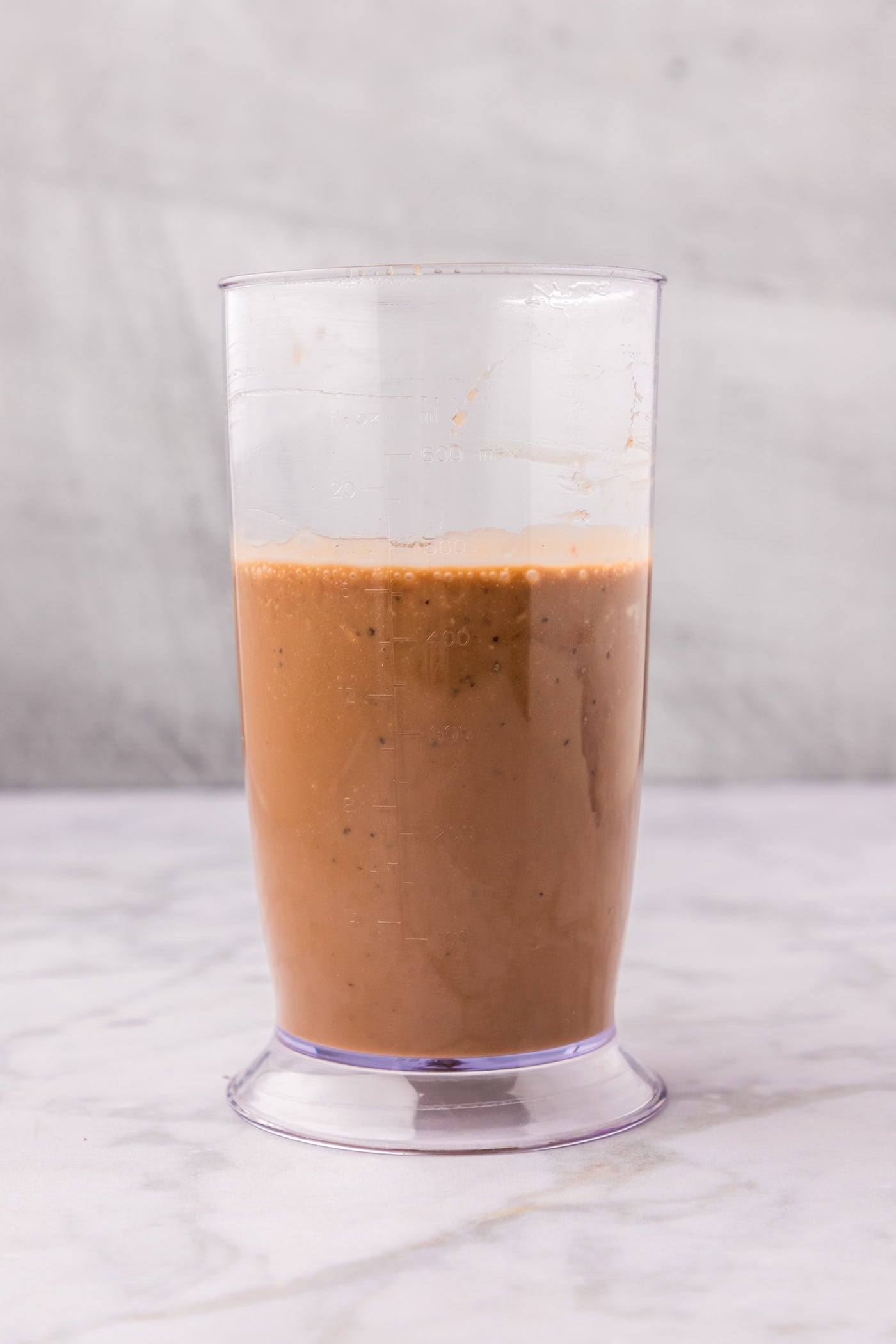
Delicious Serving Suggestions for Your Homemade Balsamic Vinaigrette
The beauty of this homemade balsamic vinaigrette lies not just in its incredible flavor, but also in its remarkable versatility. While it’s a quintessential companion for salads, don’t limit its potential!
Salad Enhancer: Naturally, this vinaigrette shines in salads. It’s particularly fantastic with salads featuring fresh fruits, where the vinaigrette’s tang beautifully complements natural sweetness. Consider combinations with sliced apples, juicy strawberries, tender peaches, or plump blueberries. For a heartier salad, try it with goat cheese, toasted walnuts or pecans, and mixed greens. It’s also superb on a classic Caprese salad with fresh mozzarella, ripe tomatoes, and basil, or drizzled over a vibrant mixed greens salad with cherry tomatoes, cucumbers, and bell peppers. It truly makes even the simplest salad feel gourmet.
Flavorful Marinade: Move beyond salads and transform your proteins. This balsamic vinaigrette makes an exceptional marinade for a variety of meats and plant-based options. Use it to infuse rich flavor into chicken breasts, pork tenderloin, beef steaks, or even firm tofu before grilling, baking, or pan-searing. Allow your chosen protein to marinate for at least 30 minutes, or for a deeper flavor, several hours in the refrigerator. The acidity of the vinegar helps tenderize while the other ingredients add immense depth.
Roasted Vegetable Dressing: Elevate your roasted vegetables from simple sides to show-stopping dishes. After roasting, a generous drizzle of this balsamic vinaigrette over carrots, broccoli, asparagus, Brussels sprouts, or bell peppers adds a burst of freshness and a beautiful sheen. It brings out their natural sweetness and adds a savory tang that is simply irresistible.
Other Creative Uses:
- Dipping Sauce: Serve it alongside crusty bread as an appetizer.
- Grain Bowls: A perfect dressing for nourishing grain bowls featuring quinoa, farro, roasted vegetables, and your favorite protein.
- Sandwiches & Wraps: Drizzle a little inside your sandwiches or wraps for an extra layer of flavor.
- Pasta Salads: Toss with cooled pasta, fresh vegetables, and feta cheese for a vibrant pasta salad.
- Pizza Drizzle: A light drizzle over a finished margherita pizza adds an unexpected but delightful gourmet touch.
No matter how you choose to use it, this homemade balsamic vinaigrette is sure to become a go-to in your kitchen for adding bright, balanced flavor to countless dishes.
More Delicious Dressing and Vinaigrette Recipes
- Creamy Dill Dressing
- Blue Cheese Dressing
- Lemon Salad Dressing
- Buttermilk Ranch Dressing
- Blueberry Vinaigrette Salad Dressing
I love to bake and cook and share my kitchen experience with all of you! Remembering to come back each day can be tough, that’s why I offer a convenient newsletter every time a new recipe posts. Simply subscribe and start receiving your free daily recipes!
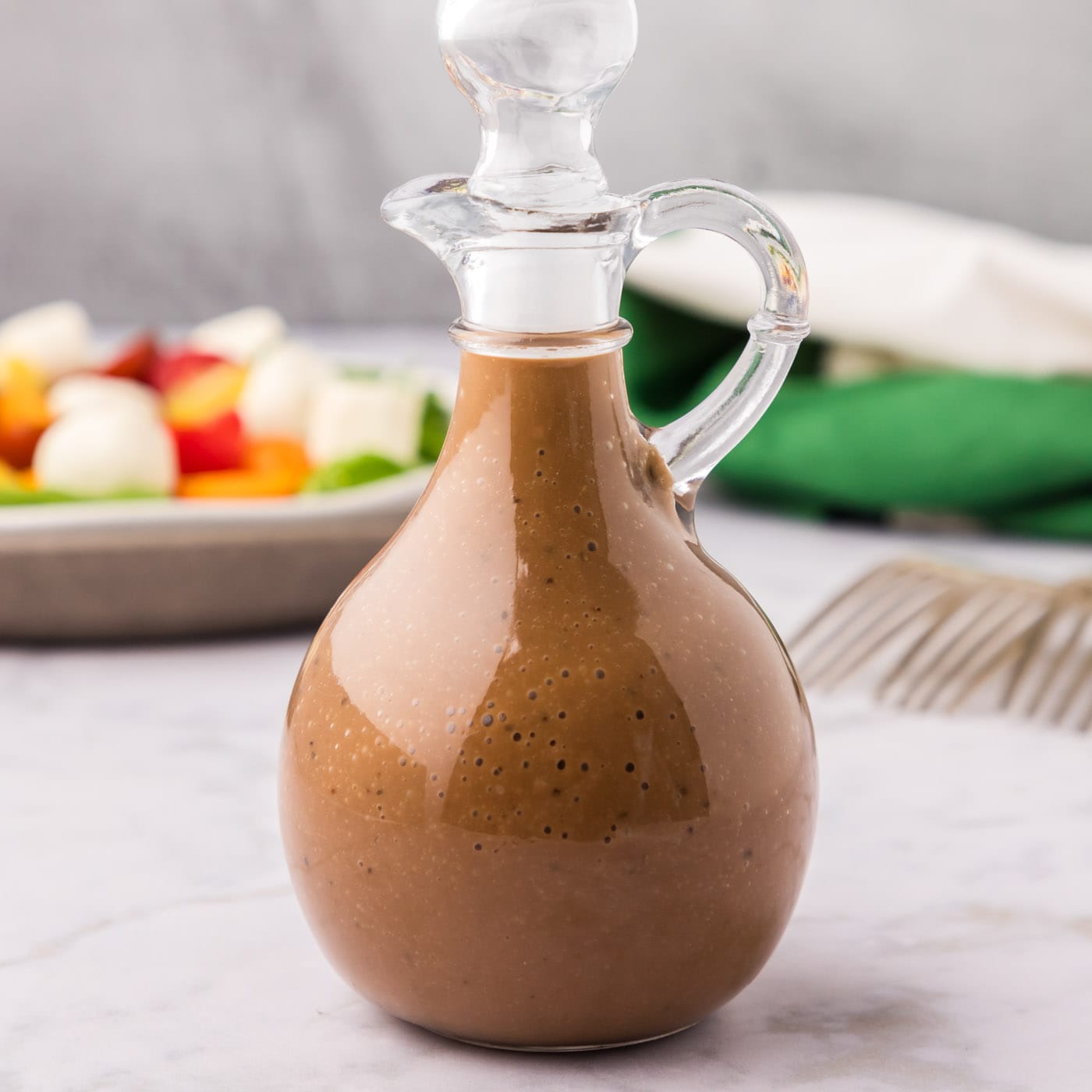
Balsamic Vinaigrette
IMPORTANT – There are often Frequently Asked Questions within the blog post that you may find helpful. Simply scroll back up to read them!
Print It
Pin It
Rate It
Save ItSaved!
Ingredients
- 1 cup balsamic vinegar
- 3 Tablespoons honey
- 2 teaspoons minced shallots
- 2 teaspoons minced garlic
- 1 Tablespoon Dijon mustard
- 2 teaspoons black pepper
- 2 teaspoons pink Himalayan salt
- ⅔ cup extra virgin olive oil
Things You’ll Need
-
immersion blender
Before You Begin
- Running the ingredients through an immersion blender will increase the volume as air is blended into the mix, creating a light froth.
- This recipe calls for regular balsamic vinegar. If using aged balsamic, which is naturally sweeter and thicker, you may need to reduce the honey.
- Extra-virgin olive oil is preferred for its flavor, but canola, sunflower, or light olive oil can be substituted, though flavor profiles may change.
- If substituting pink Himalayan salt, use another coarse-grain salt. Do not use an equal amount of fine table salt, as it is much saltier.
- Store homemade balsamic vinaigrette in an airtight container in the refrigerator for up to 1 month. It may thicken or separate; shake well before using, or warm briefly to loosen.
Instructions
-
Place all ingredients except for the olive oil into a tall, narrow container for an immersion blender.
-
Insert the immersion blender and begin blending. Slowly drizzle in the olive oil until all ingredients are well combined and the vinaigrette is smooth and emulsified.
-
Chill for at least 30 minutes before serving to allow flavors to meld and for a slightly thicker consistency.
-
Store in a sealed, airtight container in the refrigerator for up to one month. Shake well before each use.
Nutrition
The recipes on this blog are tested with a conventional gas oven and gas stovetop. It’s important to note that some ovens, especially as they age, can cook and bake inconsistently. Using an inexpensive oven thermometer can assure you that your oven is truly heating to the proper temperature. If you use a toaster oven or countertop oven, please keep in mind that they may not distribute heat the same as a conventional full sized oven and you may need to adjust your cooking/baking times. In the case of recipes made with a pressure cooker, air fryer, slow cooker, or other appliance, a link to the appliances we use is listed within each respective recipe. For baking recipes where measurements are given by weight, please note that results may not be the same if cups are used instead, and we can’t guarantee success with that method.
